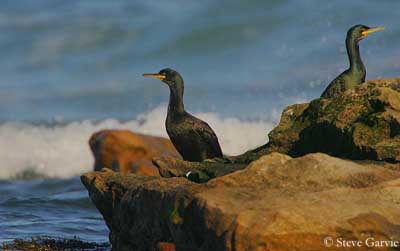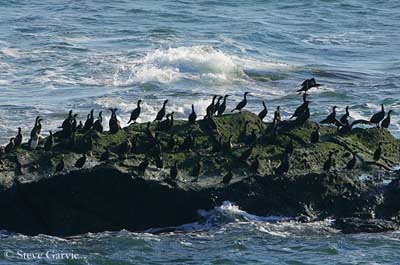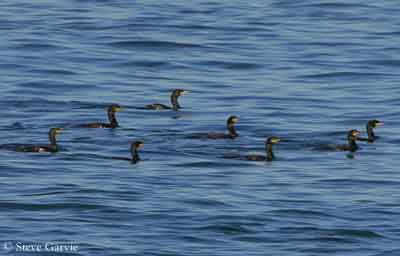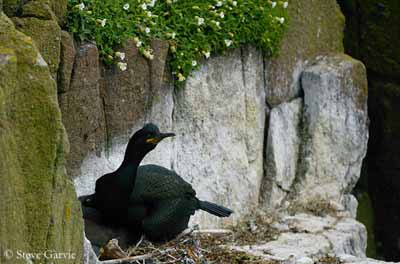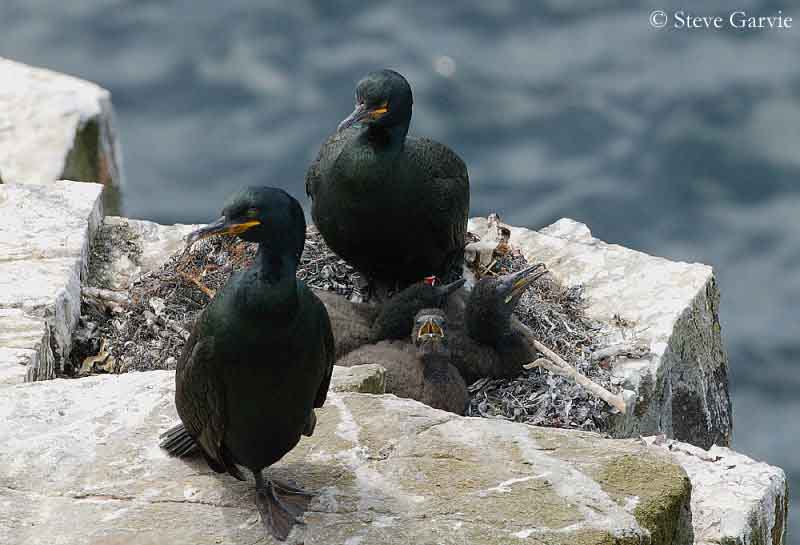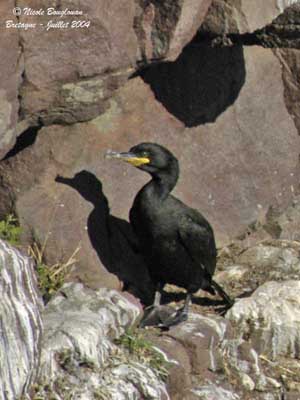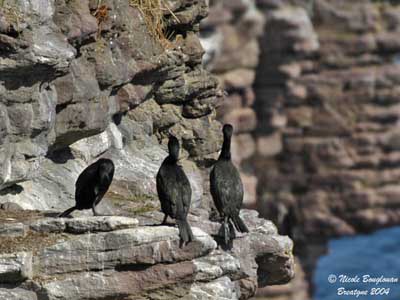
European Shag
Gulosus aristotelis
Suliformes Order – Phalacrocoracidae Family
BIOMETRICS :
Length : 65-80 cm
Wingspan : 90-105 cm
Weight : up to 2000g
LONGEVITY : up to 14 years
DESCRIPTION:
European Shag is smaller than Great Cormorant, with thinner bill and recurved crest in breeding season.
Adult in breeding plumage has all-black plumage with dark green gloss.
On the head, we can see a recurved crest on forehead during short period. The thin, blackish bill shows down curved tip of upper mandible, and bright yellow gape. Eyes are emerald green. Legs and webbed feet are blackish.
The adult in winter plumage is duller and lacks the crest. Chin and throat are greyish mottled brown.
Both sexes are similar.
Juvenile is rather brown, with pale head sides and underparts, with variable amount of greyish and whitish tones on underparts. It reaches its sexual maturity at four years.
We can find three subspecies:
P.a. aristotelis, from Iceland and N Scandinavia, southwards to Iberian Peninsula.
P.a. desmarestii, from Centre Mediterranean, eastwards to Black Sea.
P.a. riggenbachi, from Morocco coasts.
VOICE : SOUNDS BY XENO-CANTO
European Shag is rather silent away from colonies. Within the colony, male and female produce clicking sounds. Male gives series of grunts and clicks “ark-ik-ark-ik-ark-ik…”

HABITAT:
European Shag is a marine species. It frequents the rocky coasts and the islands with adjacent deep and clear waters.
This species breeds on sea cliffs and rocks, or on the ground, sheltered by vegetation or boulders. They usually avoid estuaries, and roost on rocks, at the base of the seas cliffs. It is rare inland.
RANGE:
European Shag breeds on the rocky coasts of W and S Europe, South-west Asia and North Africa.
This species is sedentary and usually winters in its breeding range, but the northernmost populations may move southwards in winter.
Immatures may perform some post-breeding dispersions and short-distance movements.
BEHAVIOUR:
European Shag feeds on fish taken at the bottom or in mid-water. This bird often forages alone when away from colonies and in winter. But it also pursues the shoals of fishes in very large flocks. It feeds mainly by diving, and then it pursues the prey underwater.
European Shag, as other cormorants’ species, is gregarious. They form large flocks at roost and at breeding colonies, and also when fishing together. The colonial roosts are usually situated in safe positions, islands, rocks and sea cliffs. But the offshore oil platforms are sometimes used for roosting by these birds, even if this marine species usually sleeps on land year round.
During disputes on perches, or when fishing in flocks, European Shags utters frequent vocalizations. These sounds are mainly produced by males, although they have very limited repertoire.
During breeding season, the European Shag has very bright-coloured gape. The displays expose these colours with the bill pointed upwards and forwards, head tossed towards the back and raised again, while the male performs “wing-waving”.
The end of the displays occurs when female lands close to the male and is accepted. At this moment, female guards the nest-site while the male collects nest-materials. Copulation occurs at nest-site.
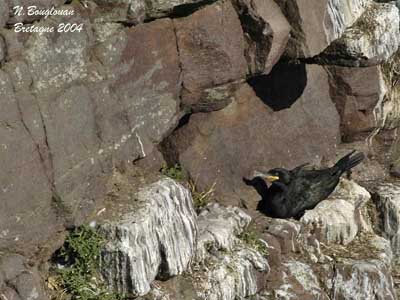
REPRODUCTION:
Breeding season varies according to the range.
European Shag nests in loose colonies in sea cliffs. The nest may be situated in crevices, caves, ledges, among boulders, a few metres above the higher level of the water.
It is made with sticks and seaweeds, mainly plant materials. Interior is lined with softer materials such as fine grasses. The nest is often reused during several seasons. Fresh material is added throughout the nesting period.
Female lays 3 pale blue eggs. Incubation lasts about one month, shared by both adults.
At hatching, chicks are naked and need their parents for warmth. Later, they are covered with brown down. They are fed by regurgitation by adults. They fledge 53 days after hatching, but they still depend on parents for food and care during about four weeks more. They are able to fly at two months of age.
Adults defend strongly the young against predators.
DIET:
European Shag feeds mainly on fish, but it also takes some molluscs and small crustaceans.
PROTECTION/THREATS/ STATUS:
European Shag is often persecuted at fisheries and fish farms where it is regarded as pest and predator for fish stocks.
As other marine species, it is vulnerable to oil pollution, and sometimes, may suffer accidental trapping in fishing nets.
In addition, adults, chicks and eggs are taken for consumption.
However, in spite of decline in 19th century, populations are now slowly increasing in recent years.
Fr: Cormoran huppé
All : Krähenscharbe
Esp : Cormorán Moñudo
Ital : Marangone dal ciuffo
Nd: Kuifaalscholver
Russe: Хохлатый баклан
Sd: Toppskarv
Photographs by Steve Garvie
His website: RAINBIRDER Photo galleries
Text and photographs by Nicole Bouglouan
Sources:
HANDBOOK OF THE BIRDS OF THE WORLD vol 1 by Josep del Hoyo-Andrew Elliot-Jordi Sargatal - Lynx Edicions - ISBN: 8487334105
THE HANDBOOK OF BIRD IDENTIFICATION FOR EUROPE AND THE WESTERN PALEARCTIC by Mark Beaman, Steve Madge - C.Helm - ISBN: 0713639601
THE COMPLETE BOOK OF BRITISH BIRDS – Written by “Royal Society for the Protection of Birds” experts - Préface de Magnus Magnusson - Michael Cady- Rob Hume Editors - ISBN: 0749509112
BirdLife International (BirdLife International)
Wikipedia (Wikipedia, The Free Encyclopedia)
